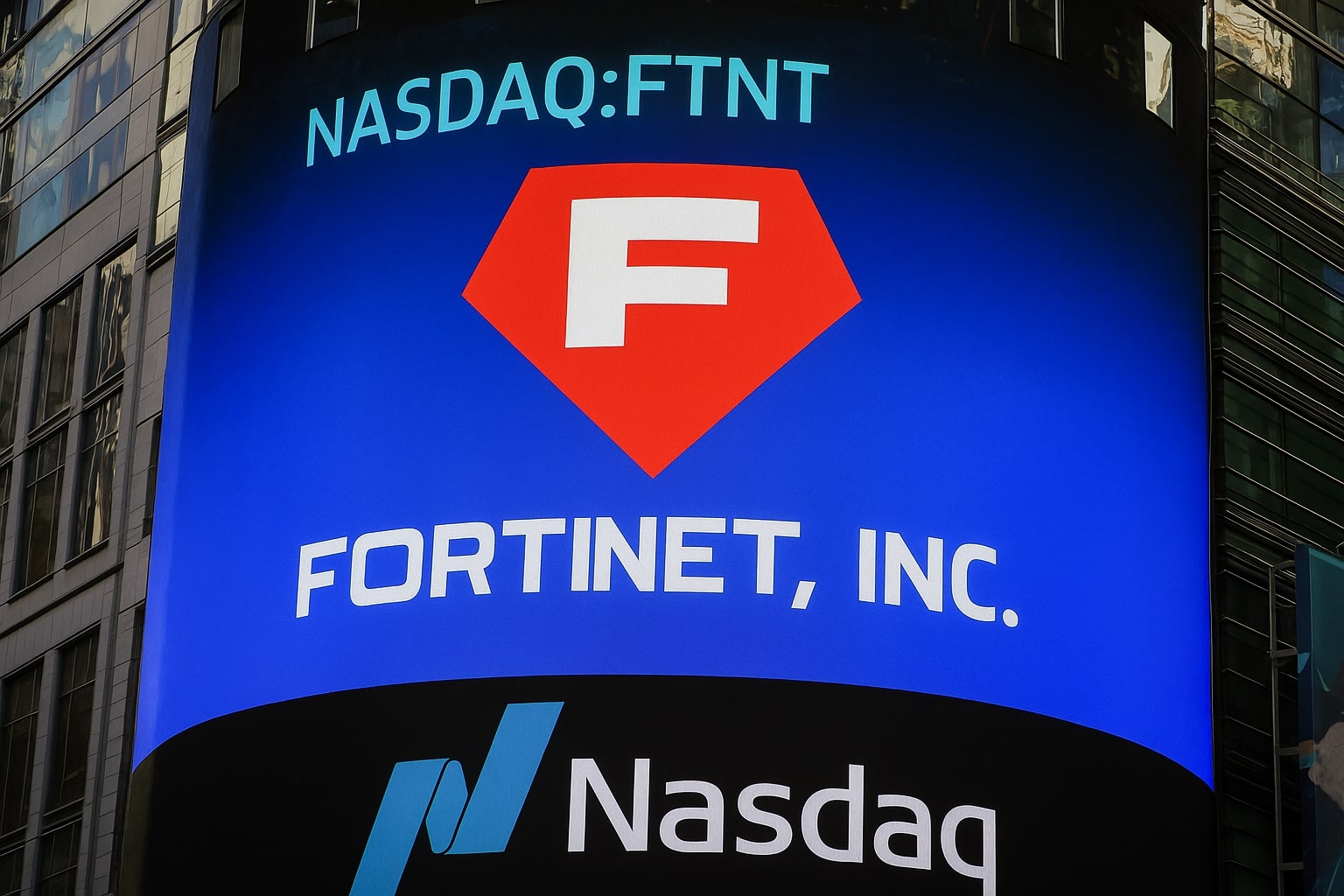
Fortinet Stock Forecast – NASDAQ:FTNT at $78.77 After Selloff, Services Drive Rebound
Fortinet’s firewall cycle concerns weigh, but SASE, SecOps and $2.07B FCF reinforce upside toward $100 | That's TradingNEWS
NASDAQ:FTNT – Fortinet Faces Market Shock but Fundamentals Hold Firm
Fortinet, Inc. (NASDAQ:FTNT) closed the last session at $78.77, marking a 0.66% decline, with after-hours trading showing a marginal dip to $78.71. The company, once valued at over $114.82 per share during its 52-week high, has now shed nearly 30% from its peaks, leaving its market capitalization at $60.36 billion. The decline followed Q2 earnings that beat expectations on EPS and showed billings growth of 15% year-over-year, yet investors punished the stock due to concerns about the firewall refresh cycle and tempered revenue guidance.
Fortinet’s Earnings Beat Overshadowed by Guidance and Renewal Commentary
Q2 revenue stood at $1.63 billion, a 14% YoY increase, with net income reaching $491.1 million and diluted EPS of $0.64, beating the estimate by 8.27%. Services revenue grew 14.1%, while product revenue climbed 12.6%, reflecting a recovery from prior quarters. Billings reached $1.73 billion, up 15% from last year, reinforcing strong demand and providing forward visibility. Despite these figures, management guided Q3 revenue to the $1.7 billion range, slightly below market expectations of $1.71 billion. The disappointment was magnified when executives disclosed that 40–50% of the firewall renewal cycle has already occurred, raising doubts about how much incremental revenue remains in this driver.
High-Margin Segments Reinforce Strategic Positioning
While investors focused on hardware cycle commentary, the real growth story continues in Fortinet’s Unified SASE and SecOps divisions. Unified SASE revenue surged 21–22% year-over-year, while SecOps advanced 31–35%, both far outpacing consolidated growth. These segments carry gross margins close to 88%, compared to 67% in products, and underpin Fortinet’s long-term thesis of expanding its software and services footprint. Deals exceeding $1 million in value grew 51% YoY, showing clear success in cross-selling and upselling to large enterprise clients.
Profitability and Cash Flow Remain Sector-Leading
Fortinet maintains sector-best profitability with an 81.6% gross margin, its highest ever. Product margins expanded to 67.8%, while service margins eased slightly to 87.8% due to cloud investments. Operating margin contracted from 35.1% to 33.1% as the company ramped up sales hiring, but this was an intentional decision to strengthen distribution capacity. Free cash flow for the trailing twelve months stands at $2.07 billion, against EBITDA of $2.44 billion, reflecting Fortinet’s strong cash generation. The balance sheet remains robust with $4.56 billion in cash and just $1.09 billion in debt, leaving ample liquidity for buybacks and reinvestment. The company repurchased $401 million in stock in H1 2025 and still holds $1.6 billion authorized for further repurchases, a strategy that historically has been well-timed.
Valuation Reset After Sharp Selloff
With the stock trading near 31x trailing earnings and 9.6x sales, valuations have compressed sharply from their early 2025 highs when multiples reached over 43x earnings and 13x sales. The PEG ratio of 2.12 now looks more aligned with expected growth rates of 10–13%. Management reiterated confidence in long-term revenue expansion, forecasting FY2025 sales of $6.75 billion and FY2026 at $7.54 billion, despite caution in near-term hardware growth. A discounted cash flow model applying a 10% WACC, 15% growth in the first five years, and 10% in the following five suggests fair value closer to $104 per share, while conservative multiples put valuation near $85, offering upside from current levels.
Insider and Institutional Positioning
Insiders currently hold 16.87% of outstanding shares, a significant stake reflecting strong alignment with shareholders. Institutions control 72.35% of the float, underscoring confidence in Fortinet’s long-term thesis. Recent filings show active insider sales but also steady institutional accumulation, details available on insider transactions. Short interest stands at 18.09 million shares, or 2.84% of float, modest but indicative of bearish sentiment during the post-earnings selloff.
Competitive Landscape and Sector Dynamics
Compared to peers, Palo Alto Networks (NASDAQ:PANW) trades near $190.52, CrowdStrike (NASDAQ:CRWD) at $423.70, and Zscaler (NASDAQ:ZS) at $277.05. Fortinet’s unique advantage is its vertically integrated hardware-plus-software model, enabled by its proprietary FortiASIC chips. While some argue this exposes the company to hardware cyclicality, it also establishes a massive installed base that feeds recurring high-margin services. The firewall refresh cycle, estimated at 650,000 units expiring in 2026, remains a tailwind even if smaller than expected. Consolidation trends—customers replacing multiple smaller devices with fewer, more powerful units—explain why renewal volumes will not translate one-to-one into revenue. However, this enhances service attach rates, making the installed base more valuable over time.
Decision Point: NASDAQ:FTNT Valuation at a Crossroads
With NASDAQ:FTNT at $78.77, nearly 40% off its 52-week highs of $114.82, the market has priced in slower product growth while overlooking accelerating SASE and SecOps services. Margins remain resilient, free cash flow generation is strong, and the balance sheet is fortified with $4.56 billion cash. Insider and institutional ownership provide confidence that management remains committed to long-term value creation. On balance, the selloff appears exaggerated, and at current levels, the stock tilts toward a Buy, with upside back to $90–$100 in the medium term and a fair value estimate above $100 based on services-led growth.
That's TradingNEWS
Read More
-
AbbVie Stock Price Forecast - ABBV at $229 Turns the Humira Cliff Into a 2026 Growth Engine
02.01.2026 · TradingNEWS ArchiveStocks
-
XRP Price Forecast - XRP-USD Nears $2 as $1.80 Support and Shrinking Supply Point to $2.60 Target
02.01.2026 · TradingNEWS ArchiveCrypto
-
Oil Price Forecast - Oil Slide Into 2026: WTI Stuck at $57, Brent at $60
02.01.2026 · TradingNEWS ArchiveCommodities
-
Stock Market Today: Nasdaq Hits 23,467 as Nvidia (NVDA), Micron (MU) and Baidu (BIDU) Drive AI Surge
02.01.2026 · TradingNEWS ArchiveMarkets
-
GBP/USD Price Forecast: Pound Holds 1.3450 as Fed–BoE Split Keeps Bulls Aiming at 1.37
02.01.2026 · TradingNEWS ArchiveForex


















